What Is The Smallest Unit Of Data In A Computer
Kalali
Jun 14, 2025 · 3 min read

Table of Contents
What is the Smallest Unit of Data in a Computer? A Deep Dive into Bits and Bytes
Understanding the fundamental building blocks of computer data is crucial for anyone interested in technology. This article will explore the smallest unit of data in a computer, explaining its role in processing information and debunking common misconceptions. We'll cover bits, bytes, and their relationship to larger data units, providing a clear and concise explanation.
The smallest unit of data in a computer is the bit. A bit, short for "binary digit," represents the most basic unit of information in a digital system. It can hold only one of two possible values: 0 or 1. Think of it as a single switch that can be either on (1) or off (0). This seemingly simple concept is the foundation upon which all digital information is built. Everything from text documents to high-resolution images is ultimately represented by a vast sequence of these 0s and 1s.
From Bits to Bytes and Beyond: Understanding Data Units
While the bit is the smallest unit, it's rarely used alone. Data is typically organized into groups of bits called bytes. A byte consists of eight bits. This grouping allows for a significantly larger range of values, enabling the representation of a broader spectrum of information. For example, a single byte can represent 256 different values (2<sup>8</sup> = 256), which is sufficient to represent a single character in many character encoding schemes like ASCII.
Moving beyond bytes, larger units are used to measure data quantities:
- Kilobyte (KB): 1,024 bytes (approximately 1,000 bytes)
- Megabyte (MB): 1,024 kilobytes (approximately 1 million bytes)
- Gigabyte (GB): 1,024 megabytes (approximately 1 billion bytes)
- Terabyte (TB): 1,024 gigabytes (approximately 1 trillion bytes)
- Petabyte (PB): 1,024 terabytes (approximately 1 quadrillion bytes)
- Exabyte (EB): 1,024 petabytes (approximately 1 quintillion bytes)
- Zettabyte (ZB): 1,024 exabytes (approximately 1 sextillion bytes)
- Yottabyte (YB): 1,024 zettabytes (approximately 1 septillion bytes)
These units are essential for understanding the storage capacity of devices like hard drives, SSDs, and USB flash drives, as well as the size of files and data transfers.
Common Misconceptions about the Smallest Unit of Data
It's important to clarify some common misunderstandings:
- Pixels are not the smallest unit: While pixels are fundamental components of images, they are composed of multiple bits representing color information. Each pixel requires several bytes to store its color data.
- Characters are not the smallest unit: Characters, like letters and numbers, are represented by a specific number of bits, typically one byte in ASCII encoding.
Conclusion: The Importance of Bits and Bytes
In conclusion, the bit, representing a single binary digit (0 or 1), is the smallest unit of data in a computer. Understanding this fundamental concept, along with the hierarchical structure of bytes and larger data units, is crucial for grasping how computers store and process information. From the seemingly simple "on" or "off" state of a bit, the vast digital world we experience today is built.
Latest Posts
Latest Posts
-
Whats The Square Root Of 288
Jun 15, 2025
-
Population Of Scheduled Caste In India
Jun 15, 2025
-
Which Of The Following Materials Is Considered A Conductor
Jun 15, 2025
-
How Do The Bhaktis And Sufis Compare
Jun 15, 2025
-
Which Of The Following Statements About Computer Networks Is True
Jun 15, 2025
Related Post
Thank you for visiting our website which covers about What Is The Smallest Unit Of Data In A Computer . We hope the information provided has been useful to you. Feel free to contact us if you have any questions or need further assistance. See you next time and don't miss to bookmark.